SOCS237: SPSS Data Analysis Report on Political Action Variables
VerifiedAdded on 2023/01/18
|9
|2031
|100
Report
AI Summary
This SPSS report presents an analysis of data concerning political action, examining its relationships with education level, age, and interest in politics. The study employs correlation and t-tests to investigate these relationships within a sample of 1477 respondents. Key findings include a weak negative correlation between education and political action, a small weak negative correlation between age and political action, and a strong positive correlation between interest in politics and political action. Additionally, the report compares political action scores between males and females using a t-test, revealing a significant difference. The discussion section interprets these results in the context of existing literature, considering factors such as democratic stability, gender theory, and political participation. The report concludes with a summary of the findings, emphasizing the complex interplay of these variables in shaping political behavior. The report includes the sample size, means, standard deviations, and significance levels for each test. This report is a comprehensive analysis of the given data.

Running head: SPSS SAMPLE REPORT 1
SPSS Sample Report
Name
Institution
SPSS Sample Report
Name
Institution
Paraphrase This Document
Need a fresh take? Get an instant paraphrase of this document with our AI Paraphraser
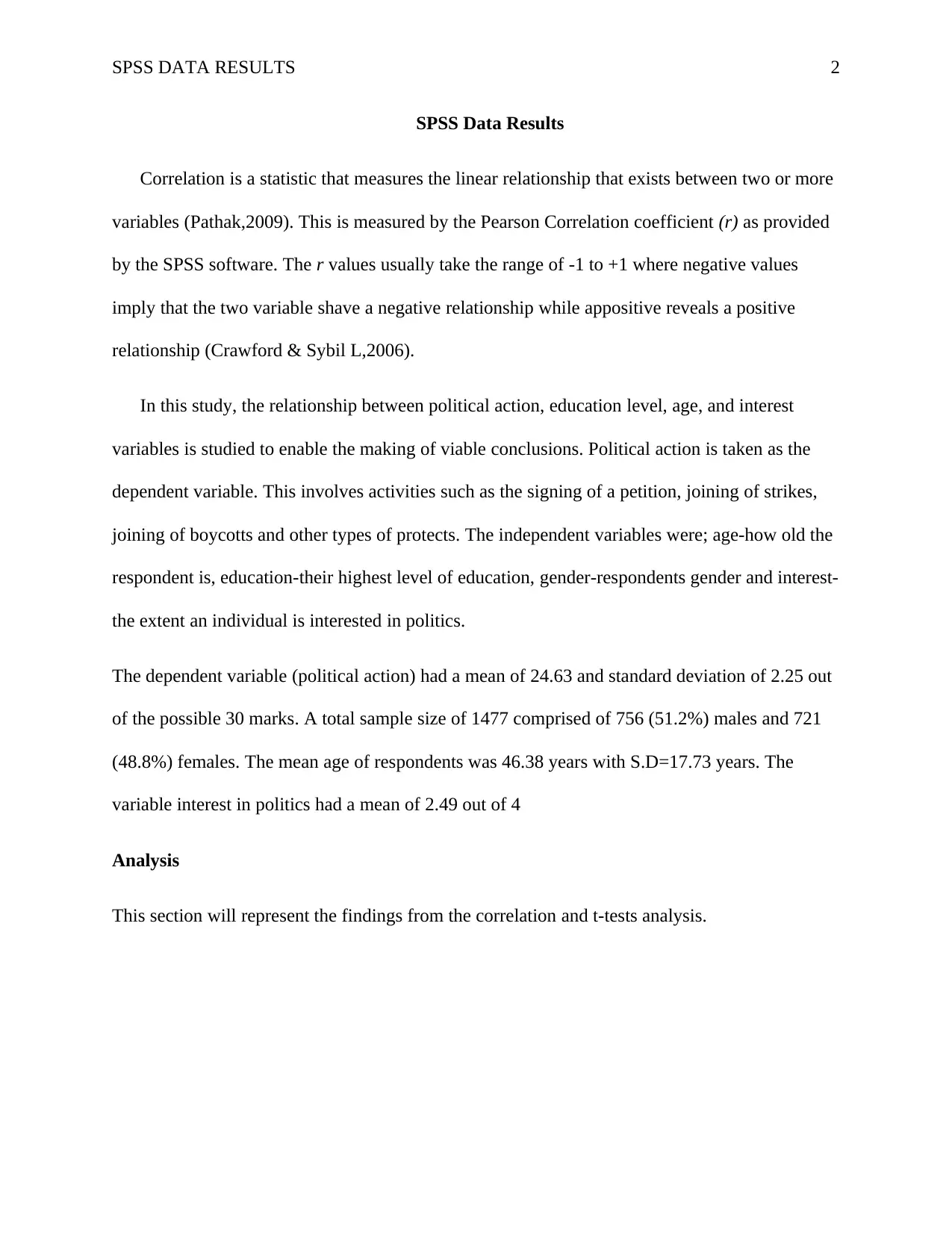
SPSS DATA RESULTS 2
SPSS Data Results
Correlation is a statistic that measures the linear relationship that exists between two or more
variables (Pathak,2009). This is measured by the Pearson Correlation coefficient (r) as provided
by the SPSS software. The r values usually take the range of -1 to +1 where negative values
imply that the two variable shave a negative relationship while appositive reveals a positive
relationship (Crawford & Sybil L,2006).
In this study, the relationship between political action, education level, age, and interest
variables is studied to enable the making of viable conclusions. Political action is taken as the
dependent variable. This involves activities such as the signing of a petition, joining of strikes,
joining of boycotts and other types of protects. The independent variables were; age-how old the
respondent is, education-their highest level of education, gender-respondents gender and interest-
the extent an individual is interested in politics.
The dependent variable (political action) had a mean of 24.63 and standard deviation of 2.25 out
of the possible 30 marks. A total sample size of 1477 comprised of 756 (51.2%) males and 721
(48.8%) females. The mean age of respondents was 46.38 years with S.D=17.73 years. The
variable interest in politics had a mean of 2.49 out of 4
Analysis
This section will represent the findings from the correlation and t-tests analysis.
SPSS Data Results
Correlation is a statistic that measures the linear relationship that exists between two or more
variables (Pathak,2009). This is measured by the Pearson Correlation coefficient (r) as provided
by the SPSS software. The r values usually take the range of -1 to +1 where negative values
imply that the two variable shave a negative relationship while appositive reveals a positive
relationship (Crawford & Sybil L,2006).
In this study, the relationship between political action, education level, age, and interest
variables is studied to enable the making of viable conclusions. Political action is taken as the
dependent variable. This involves activities such as the signing of a petition, joining of strikes,
joining of boycotts and other types of protects. The independent variables were; age-how old the
respondent is, education-their highest level of education, gender-respondents gender and interest-
the extent an individual is interested in politics.
The dependent variable (political action) had a mean of 24.63 and standard deviation of 2.25 out
of the possible 30 marks. A total sample size of 1477 comprised of 756 (51.2%) males and 721
(48.8%) females. The mean age of respondents was 46.38 years with S.D=17.73 years. The
variable interest in politics had a mean of 2.49 out of 4
Analysis
This section will represent the findings from the correlation and t-tests analysis.
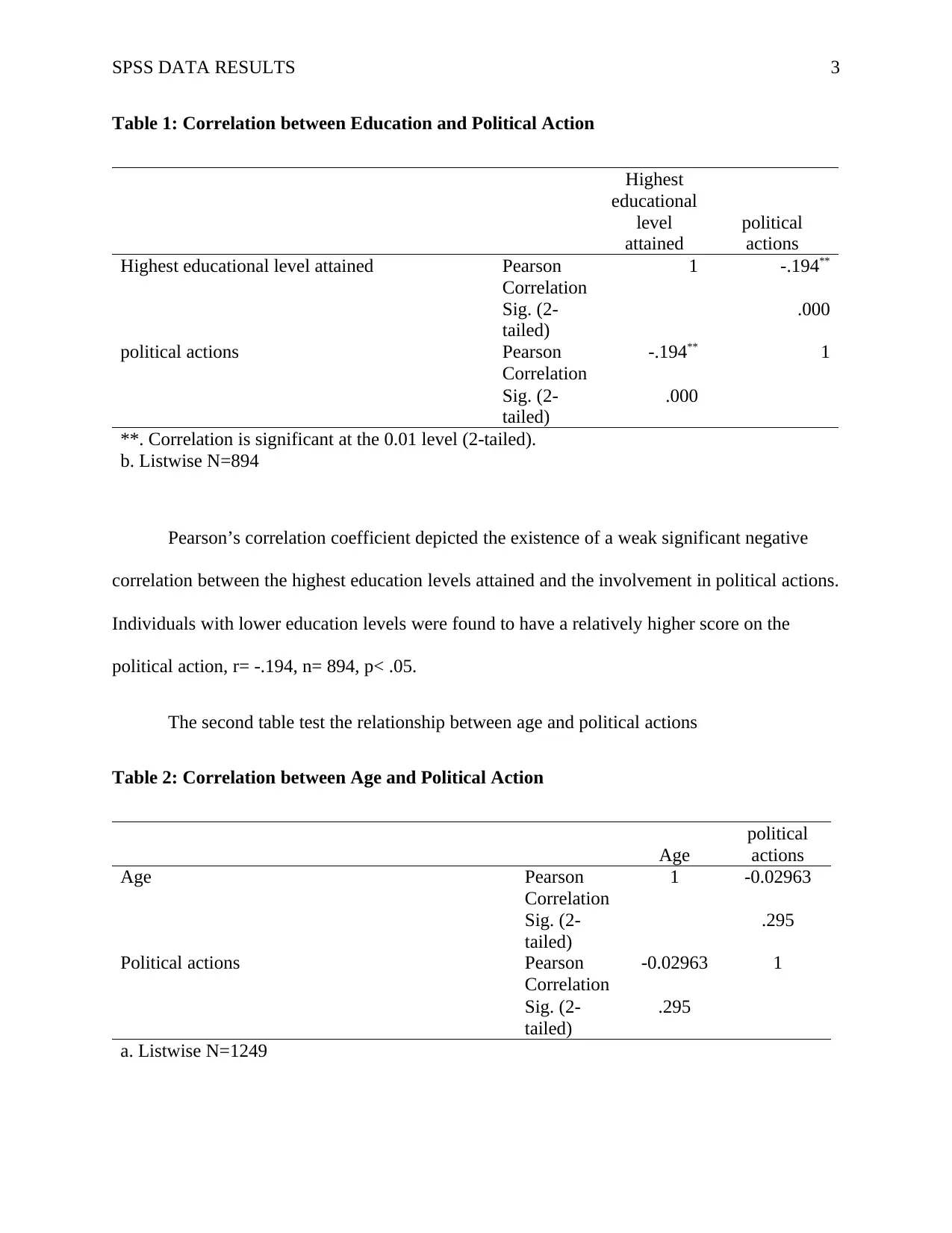
SPSS DATA RESULTS 3
Table 1: Correlation between Education and Political Action
Highest
educational
level
attained
political
actions
Highest educational level attained Pearson
Correlation
1 -.194**
Sig. (2-
tailed)
.000
political actions Pearson
Correlation
-.194** 1
Sig. (2-
tailed)
.000
**. Correlation is significant at the 0.01 level (2-tailed).
b. Listwise N=894
Pearson’s correlation coefficient depicted the existence of a weak significant negative
correlation between the highest education levels attained and the involvement in political actions.
Individuals with lower education levels were found to have a relatively higher score on the
political action, r= -.194, n= 894, p< .05.
The second table test the relationship between age and political actions
Table 2: Correlation between Age and Political Action
Age
political
actions
Age Pearson
Correlation
1 -0.02963
Sig. (2-
tailed)
.295
Political actions Pearson
Correlation
-0.02963 1
Sig. (2-
tailed)
.295
a. Listwise N=1249
Table 1: Correlation between Education and Political Action
Highest
educational
level
attained
political
actions
Highest educational level attained Pearson
Correlation
1 -.194**
Sig. (2-
tailed)
.000
political actions Pearson
Correlation
-.194** 1
Sig. (2-
tailed)
.000
**. Correlation is significant at the 0.01 level (2-tailed).
b. Listwise N=894
Pearson’s correlation coefficient depicted the existence of a weak significant negative
correlation between the highest education levels attained and the involvement in political actions.
Individuals with lower education levels were found to have a relatively higher score on the
political action, r= -.194, n= 894, p< .05.
The second table test the relationship between age and political actions
Table 2: Correlation between Age and Political Action
Age
political
actions
Age Pearson
Correlation
1 -0.02963
Sig. (2-
tailed)
.295
Political actions Pearson
Correlation
-0.02963 1
Sig. (2-
tailed)
.295
a. Listwise N=1249
⊘ This is a preview!⊘
Do you want full access?
Subscribe today to unlock all pages.

Trusted by 1+ million students worldwide
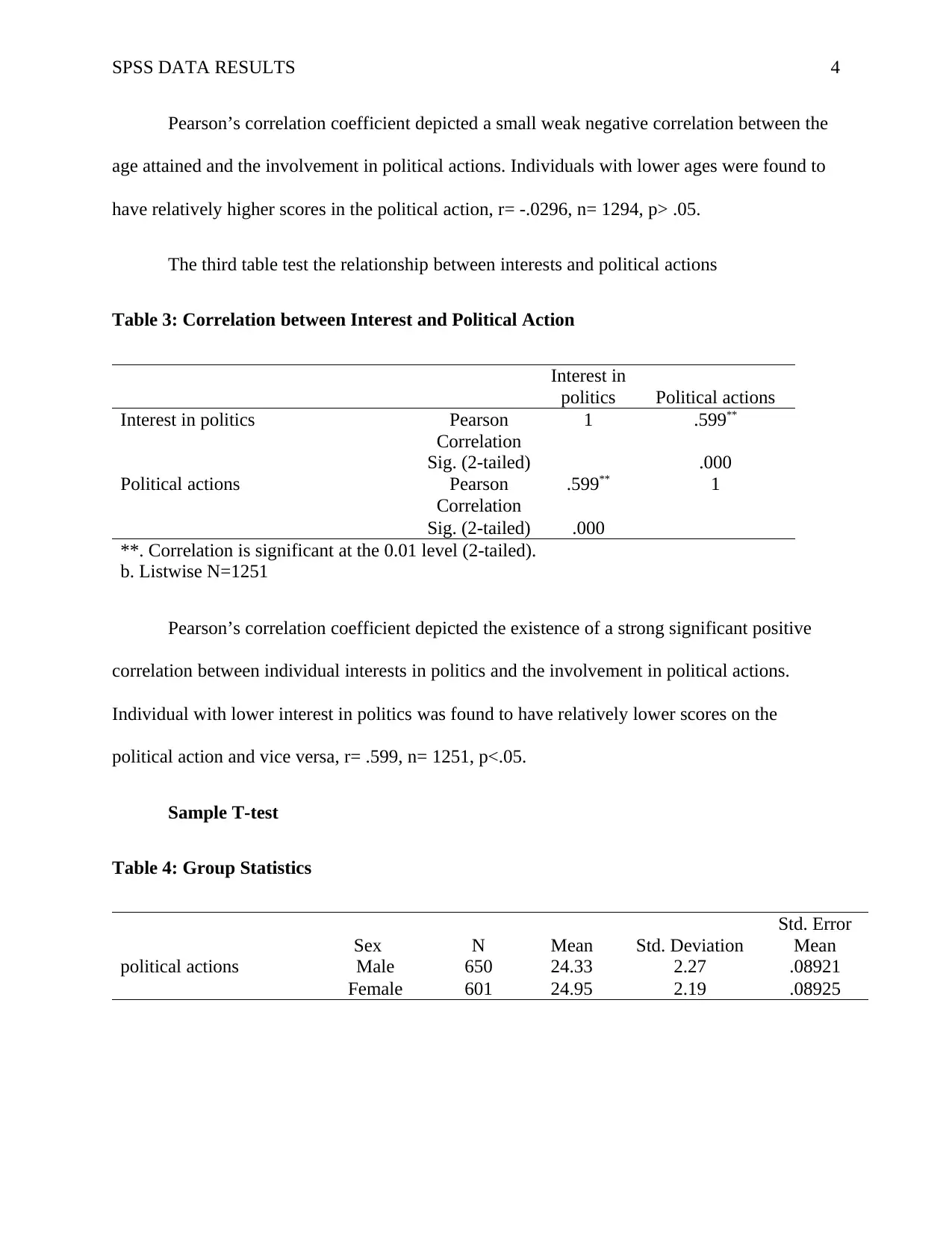
SPSS DATA RESULTS 4
Pearson’s correlation coefficient depicted a small weak negative correlation between the
age attained and the involvement in political actions. Individuals with lower ages were found to
have relatively higher scores in the political action, r= -.0296, n= 1294, p> .05.
The third table test the relationship between interests and political actions
Table 3: Correlation between Interest and Political Action
Interest in
politics Political actions
Interest in politics Pearson
Correlation
1 .599**
Sig. (2-tailed) .000
Political actions Pearson
Correlation
.599** 1
Sig. (2-tailed) .000
**. Correlation is significant at the 0.01 level (2-tailed).
b. Listwise N=1251
Pearson’s correlation coefficient depicted the existence of a strong significant positive
correlation between individual interests in politics and the involvement in political actions.
Individual with lower interest in politics was found to have relatively lower scores on the
political action and vice versa, r= .599, n= 1251, p<.05.
Sample T-test
Table 4: Group Statistics
Sex N Mean Std. Deviation
Std. Error
Mean
political actions Male 650 24.33 2.27 .08921
Female 601 24.95 2.19 .08925
Pearson’s correlation coefficient depicted a small weak negative correlation between the
age attained and the involvement in political actions. Individuals with lower ages were found to
have relatively higher scores in the political action, r= -.0296, n= 1294, p> .05.
The third table test the relationship between interests and political actions
Table 3: Correlation between Interest and Political Action
Interest in
politics Political actions
Interest in politics Pearson
Correlation
1 .599**
Sig. (2-tailed) .000
Political actions Pearson
Correlation
.599** 1
Sig. (2-tailed) .000
**. Correlation is significant at the 0.01 level (2-tailed).
b. Listwise N=1251
Pearson’s correlation coefficient depicted the existence of a strong significant positive
correlation between individual interests in politics and the involvement in political actions.
Individual with lower interest in politics was found to have relatively lower scores on the
political action and vice versa, r= .599, n= 1251, p<.05.
Sample T-test
Table 4: Group Statistics
Sex N Mean Std. Deviation
Std. Error
Mean
political actions Male 650 24.33 2.27 .08921
Female 601 24.95 2.19 .08925
Paraphrase This Document
Need a fresh take? Get an instant paraphrase of this document with our AI Paraphraser
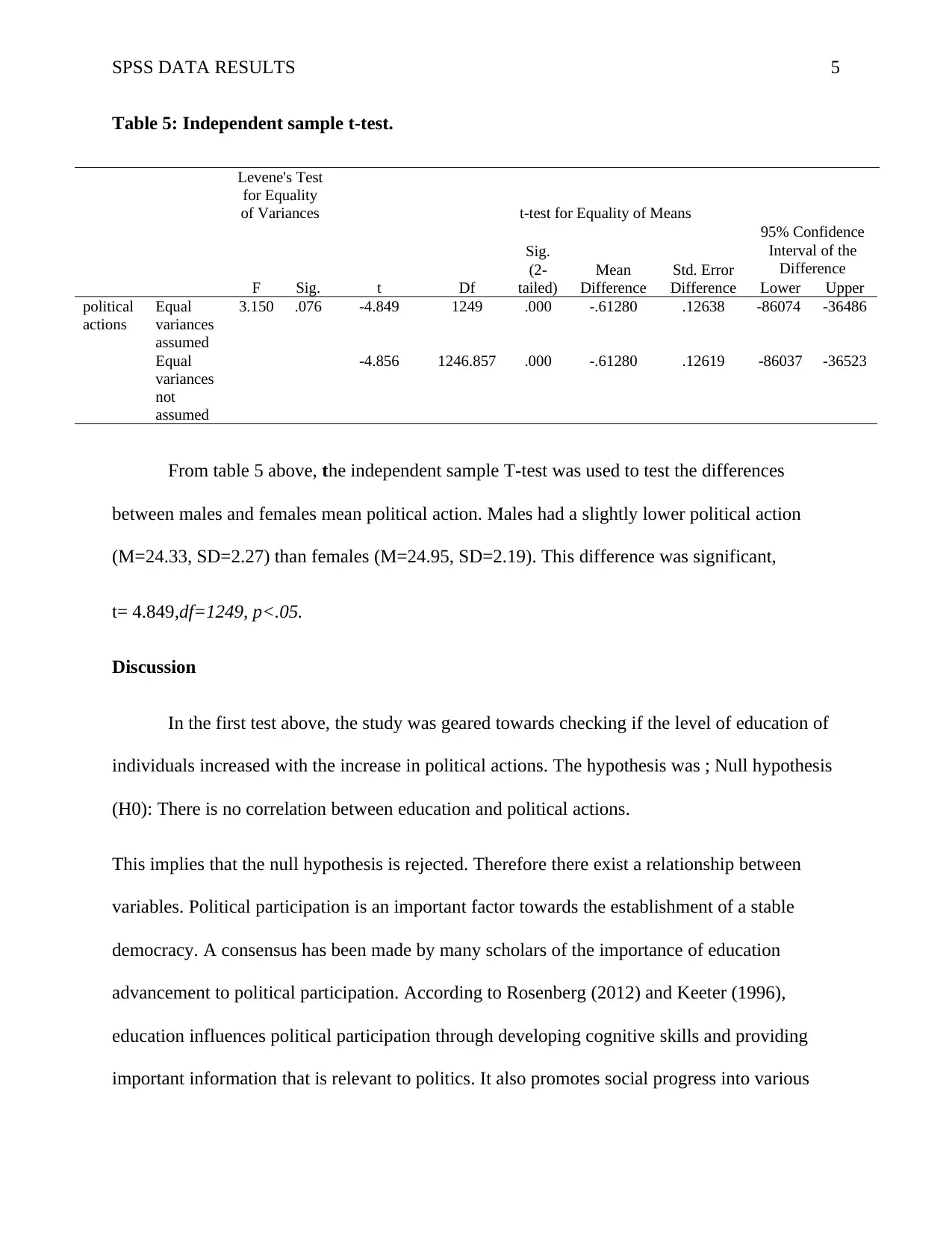
SPSS DATA RESULTS 5
Table 5: Independent sample t-test.
Levene's Test
for Equality
of Variances t-test for Equality of Means
F Sig. t Df
Sig.
(2-
tailed)
Mean
Difference
Std. Error
Difference
95% Confidence
Interval of the
Difference
Lower Upper
political
actions
Equal
variances
assumed
3.150 .076 -4.849 1249 .000 -.61280 .12638 -86074 -36486
Equal
variances
not
assumed
-4.856 1246.857 .000 -.61280 .12619 -86037 -36523
From table 5 above, the independent sample T-test was used to test the differences
between males and females mean political action. Males had a slightly lower political action
(M=24.33, SD=2.27) than females (M=24.95, SD=2.19). This difference was significant,
t= 4.849,df=1249, p<.05.
Discussion
In the first test above, the study was geared towards checking if the level of education of
individuals increased with the increase in political actions. The hypothesis was ; Null hypothesis
(H0): There is no correlation between education and political actions.
This implies that the null hypothesis is rejected. Therefore there exist a relationship between
variables. Political participation is an important factor towards the establishment of a stable
democracy. A consensus has been made by many scholars of the importance of education
advancement to political participation. According to Rosenberg (2012) and Keeter (1996),
education influences political participation through developing cognitive skills and providing
important information that is relevant to politics. It also promotes social progress into various
Table 5: Independent sample t-test.
Levene's Test
for Equality
of Variances t-test for Equality of Means
F Sig. t Df
Sig.
(2-
tailed)
Mean
Difference
Std. Error
Difference
95% Confidence
Interval of the
Difference
Lower Upper
political
actions
Equal
variances
assumed
3.150 .076 -4.849 1249 .000 -.61280 .12638 -86074 -36486
Equal
variances
not
assumed
-4.856 1246.857 .000 -.61280 .12619 -86037 -36523
From table 5 above, the independent sample T-test was used to test the differences
between males and females mean political action. Males had a slightly lower political action
(M=24.33, SD=2.27) than females (M=24.95, SD=2.19). This difference was significant,
t= 4.849,df=1249, p<.05.
Discussion
In the first test above, the study was geared towards checking if the level of education of
individuals increased with the increase in political actions. The hypothesis was ; Null hypothesis
(H0): There is no correlation between education and political actions.
This implies that the null hypothesis is rejected. Therefore there exist a relationship between
variables. Political participation is an important factor towards the establishment of a stable
democracy. A consensus has been made by many scholars of the importance of education
advancement to political participation. According to Rosenberg (2012) and Keeter (1996),
education influences political participation through developing cognitive skills and providing
important information that is relevant to politics. It also promotes social progress into various

SPSS DATA RESULTS 6
political networks. According to Almond and Verba (2015) there exist a positive relationship
between education levels and the political participation of individuals. Similarly, Hillygus (2005)
terms education as a primary driver towards increased political participation in any democracy.
Though the results of this study show a negative relationship, this could be attributed to the
democracy levels of the residents. Areas, where democracy is stable political action, is fueled by
elites. However, is developing countries and young democracies, the less educated are bribed and
influenced by leaders to get involved in political action
The second test was geared towards finding out is the age of respondents increased with their
political actions. The hypothesis was; Null hypothesis (H0): There is no correlation .This implies
that the null hypothesis is accepted since the negative correlation was not statistically significant
at alpha=0.05. According to Melo & Stockemer (2014) the relationship between age and the
various types of political engagement, in most times is not linear. This is because younger
generations are sometimes are less likely to vote compared to than their older counterparts. Also,
individuals less than 30 years were found to be significantly more likely to be involved in
political activities such as demonstrations. Individuals between 35 and 65 years were found to be
more likely involved in petitions in court. These theories suggest that young people will tend to
get involved in politics at different levels and their relationship is not linear. This is well
portrayed by the results.
The third test was supposed to check the relationship between levels of individual interests and
political action. The study revealed a positive correlation was statistically significant. The null
hypothesis is therefore rejected. This, therefore, suggests that there is sufficient evidence to
conclude that the level of interest increases with an increase in political action. It is also true that
the level of interest decreases with a decrease in political action. This is consistent with studies
political networks. According to Almond and Verba (2015) there exist a positive relationship
between education levels and the political participation of individuals. Similarly, Hillygus (2005)
terms education as a primary driver towards increased political participation in any democracy.
Though the results of this study show a negative relationship, this could be attributed to the
democracy levels of the residents. Areas, where democracy is stable political action, is fueled by
elites. However, is developing countries and young democracies, the less educated are bribed and
influenced by leaders to get involved in political action
The second test was geared towards finding out is the age of respondents increased with their
political actions. The hypothesis was; Null hypothesis (H0): There is no correlation .This implies
that the null hypothesis is accepted since the negative correlation was not statistically significant
at alpha=0.05. According to Melo & Stockemer (2014) the relationship between age and the
various types of political engagement, in most times is not linear. This is because younger
generations are sometimes are less likely to vote compared to than their older counterparts. Also,
individuals less than 30 years were found to be significantly more likely to be involved in
political activities such as demonstrations. Individuals between 35 and 65 years were found to be
more likely involved in petitions in court. These theories suggest that young people will tend to
get involved in politics at different levels and their relationship is not linear. This is well
portrayed by the results.
The third test was supposed to check the relationship between levels of individual interests and
political action. The study revealed a positive correlation was statistically significant. The null
hypothesis is therefore rejected. This, therefore, suggests that there is sufficient evidence to
conclude that the level of interest increases with an increase in political action. It is also true that
the level of interest decreases with a decrease in political action. This is consistent with studies
⊘ This is a preview!⊘
Do you want full access?
Subscribe today to unlock all pages.

Trusted by 1+ million students worldwide
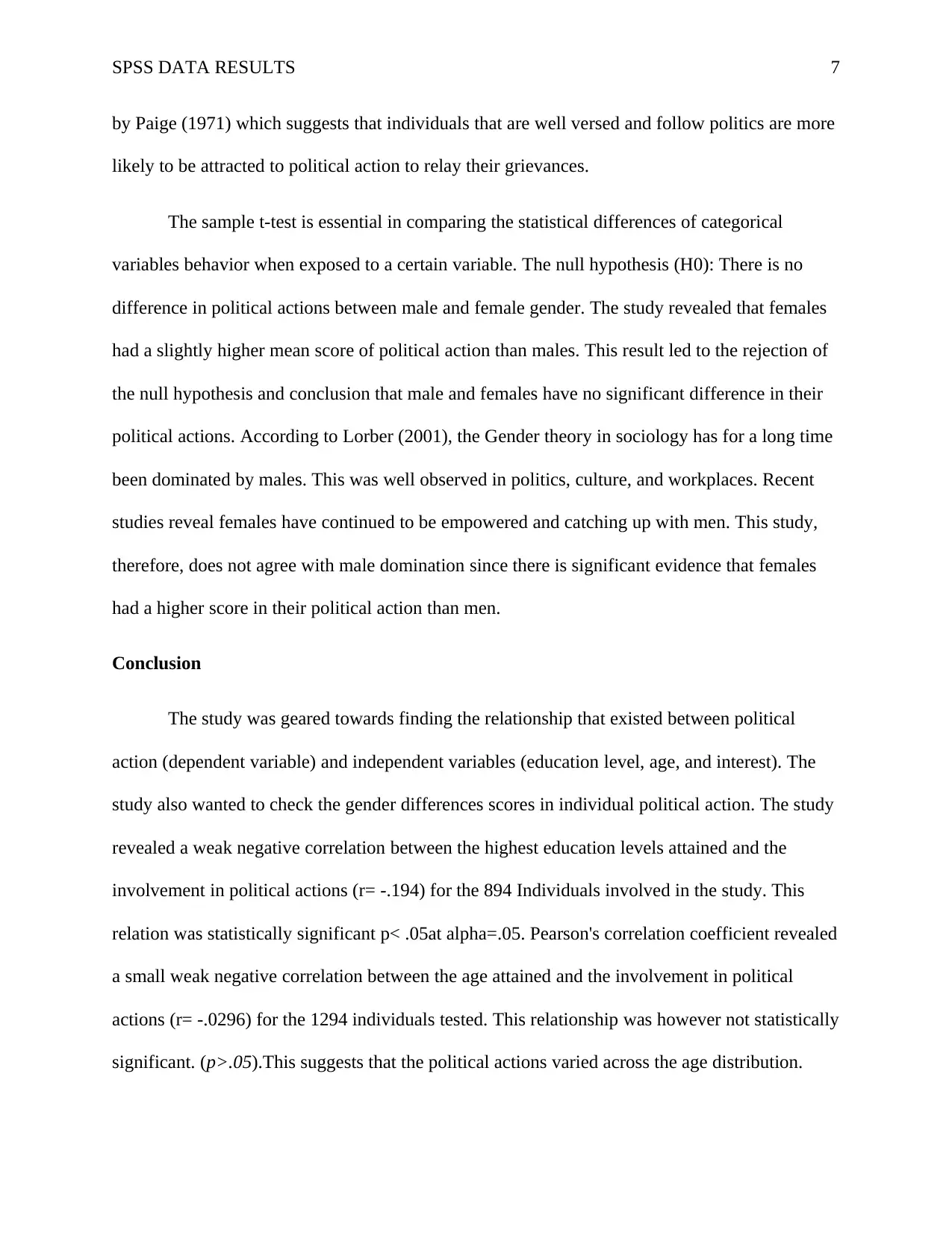
SPSS DATA RESULTS 7
by Paige (1971) which suggests that individuals that are well versed and follow politics are more
likely to be attracted to political action to relay their grievances.
The sample t-test is essential in comparing the statistical differences of categorical
variables behavior when exposed to a certain variable. The null hypothesis (H0): There is no
difference in political actions between male and female gender. The study revealed that females
had a slightly higher mean score of political action than males. This result led to the rejection of
the null hypothesis and conclusion that male and females have no significant difference in their
political actions. According to Lorber (2001), the Gender theory in sociology has for a long time
been dominated by males. This was well observed in politics, culture, and workplaces. Recent
studies reveal females have continued to be empowered and catching up with men. This study,
therefore, does not agree with male domination since there is significant evidence that females
had a higher score in their political action than men.
Conclusion
The study was geared towards finding the relationship that existed between political
action (dependent variable) and independent variables (education level, age, and interest). The
study also wanted to check the gender differences scores in individual political action. The study
revealed a weak negative correlation between the highest education levels attained and the
involvement in political actions (r= -.194) for the 894 Individuals involved in the study. This
relation was statistically significant p< .05at alpha=.05. Pearson's correlation coefficient revealed
a small weak negative correlation between the age attained and the involvement in political
actions (r= -.0296) for the 1294 individuals tested. This relationship was however not statistically
significant. (p>.05).This suggests that the political actions varied across the age distribution.
by Paige (1971) which suggests that individuals that are well versed and follow politics are more
likely to be attracted to political action to relay their grievances.
The sample t-test is essential in comparing the statistical differences of categorical
variables behavior when exposed to a certain variable. The null hypothesis (H0): There is no
difference in political actions between male and female gender. The study revealed that females
had a slightly higher mean score of political action than males. This result led to the rejection of
the null hypothesis and conclusion that male and females have no significant difference in their
political actions. According to Lorber (2001), the Gender theory in sociology has for a long time
been dominated by males. This was well observed in politics, culture, and workplaces. Recent
studies reveal females have continued to be empowered and catching up with men. This study,
therefore, does not agree with male domination since there is significant evidence that females
had a higher score in their political action than men.
Conclusion
The study was geared towards finding the relationship that existed between political
action (dependent variable) and independent variables (education level, age, and interest). The
study also wanted to check the gender differences scores in individual political action. The study
revealed a weak negative correlation between the highest education levels attained and the
involvement in political actions (r= -.194) for the 894 Individuals involved in the study. This
relation was statistically significant p< .05at alpha=.05. Pearson's correlation coefficient revealed
a small weak negative correlation between the age attained and the involvement in political
actions (r= -.0296) for the 1294 individuals tested. This relationship was however not statistically
significant. (p>.05).This suggests that the political actions varied across the age distribution.
Paraphrase This Document
Need a fresh take? Get an instant paraphrase of this document with our AI Paraphraser

SPSS DATA RESULTS 8
A strong positive correlation between individual interests in politics and the involvement
in political actions was realized. (r=.599) from the 1251 valid responses. This implies that
individual with lower interest in politics was found to have relatively lower scores on political
action and vice versa. This relationship was found to be significant (p<.05).
Lastly, there existed statistical significant differences in political actions between male
and female gender. The female gender was found to have a slightly higher mean score of
political action compared to males (p<.05) at alpha=0.05.This is consistent with Connell (2013)
finding that women have been empowerment and taking lead in societal issues.
A strong positive correlation between individual interests in politics and the involvement
in political actions was realized. (r=.599) from the 1251 valid responses. This implies that
individual with lower interest in politics was found to have relatively lower scores on political
action and vice versa. This relationship was found to be significant (p<.05).
Lastly, there existed statistical significant differences in political actions between male
and female gender. The female gender was found to have a slightly higher mean score of
political action compared to males (p<.05) at alpha=0.05.This is consistent with Connell (2013)
finding that women have been empowerment and taking lead in societal issues.
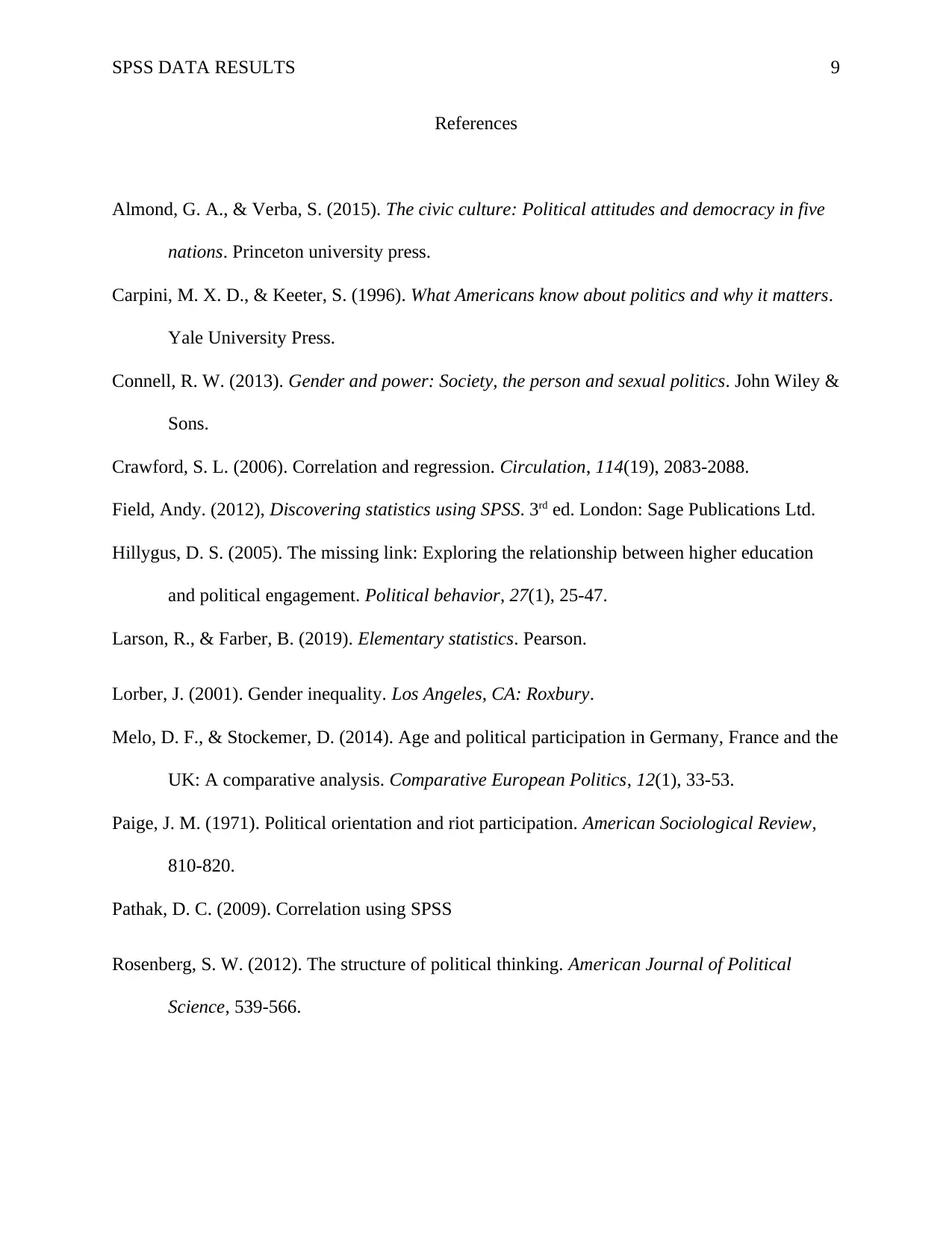
SPSS DATA RESULTS 9
References
Almond, G. A., & Verba, S. (2015). The civic culture: Political attitudes and democracy in five
nations. Princeton university press.
Carpini, M. X. D., & Keeter, S. (1996). What Americans know about politics and why it matters.
Yale University Press.
Connell, R. W. (2013). Gender and power: Society, the person and sexual politics. John Wiley &
Sons.
Crawford, S. L. (2006). Correlation and regression. Circulation, 114(19), 2083-2088.
Field, Andy. (2012), Discovering statistics using SPSS. 3rd ed. London: Sage Publications Ltd.
Hillygus, D. S. (2005). The missing link: Exploring the relationship between higher education
and political engagement. Political behavior, 27(1), 25-47.
Larson, R., & Farber, B. (2019). Elementary statistics. Pearson.
Lorber, J. (2001). Gender inequality. Los Angeles, CA: Roxbury.
Melo, D. F., & Stockemer, D. (2014). Age and political participation in Germany, France and the
UK: A comparative analysis. Comparative European Politics, 12(1), 33-53.
Paige, J. M. (1971). Political orientation and riot participation. American Sociological Review,
810-820.
Pathak, D. C. (2009). Correlation using SPSS
Rosenberg, S. W. (2012). The structure of political thinking. American Journal of Political
Science, 539-566.
References
Almond, G. A., & Verba, S. (2015). The civic culture: Political attitudes and democracy in five
nations. Princeton university press.
Carpini, M. X. D., & Keeter, S. (1996). What Americans know about politics and why it matters.
Yale University Press.
Connell, R. W. (2013). Gender and power: Society, the person and sexual politics. John Wiley &
Sons.
Crawford, S. L. (2006). Correlation and regression. Circulation, 114(19), 2083-2088.
Field, Andy. (2012), Discovering statistics using SPSS. 3rd ed. London: Sage Publications Ltd.
Hillygus, D. S. (2005). The missing link: Exploring the relationship between higher education
and political engagement. Political behavior, 27(1), 25-47.
Larson, R., & Farber, B. (2019). Elementary statistics. Pearson.
Lorber, J. (2001). Gender inequality. Los Angeles, CA: Roxbury.
Melo, D. F., & Stockemer, D. (2014). Age and political participation in Germany, France and the
UK: A comparative analysis. Comparative European Politics, 12(1), 33-53.
Paige, J. M. (1971). Political orientation and riot participation. American Sociological Review,
810-820.
Pathak, D. C. (2009). Correlation using SPSS
Rosenberg, S. W. (2012). The structure of political thinking. American Journal of Political
Science, 539-566.
⊘ This is a preview!⊘
Do you want full access?
Subscribe today to unlock all pages.

Trusted by 1+ million students worldwide
1 out of 9
Related Documents
Your All-in-One AI-Powered Toolkit for Academic Success.
+13062052269
info@desklib.com
Available 24*7 on WhatsApp / Email
![[object Object]](/_next/static/media/star-bottom.7253800d.svg)
Unlock your academic potential
Copyright © 2020–2025 A2Z Services. All Rights Reserved. Developed and managed by ZUCOL.


![Statistics Assignment 2: SPSS Analysis and Report - [University Name]](/_next/image/?url=https%3A%2F%2Fdesklib.com%2Fmedia%2Fimages%2Fin%2F8784072a20714d2aa647583645940fe0.jpg&w=256&q=75)


